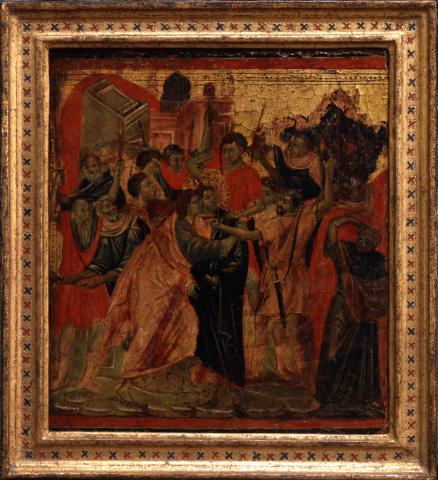Capture of Christ in the Garden
Capture of Christ in the Garden
Italian, ca. 1250-1299
Early Renaissance
oil paint on wood panel
height 17.8 cm
width 15.9 cm
Portland Art Museum, 65.55
Gift of Samuel H. Kress Foundation
Brad Blando, Medieval Portland Capstone Student, Winter 2005
This painting was a gift to the Portland Art Museum from the Samuel H. Kress Foundation. It has no known author, but most scholars now attribute it to a contemporary of the late medieval Florentine painter Cimabue.
This altarpiece has a lavish gold and red color scheme, and the linear patterning of the drapes reflects the Byzantine tradition of painting popular during the 1200s. The painting's composition is very symmetrical, with Christ in the literal center of the piece. Every aspect is evenly distributed and unified. The piece is two-dimensional with the heads in the foreground being the same size as the heads in the background. The artwork shows very unnatural light, with light sources appearing to come from all over. The color of the painting emphasizes gold tones and tempera reds. The limited gold leaf was mainly applied across the sky and in the saintly halo of Christ. The surface quality and texture of the piece are smooth with barely seen brush strokes. This piece is part of a series of small altar paintings showing the Passion of Christ, with this painting's theme dealing with the capture of Christ in the garden.
The altarpieces and altar frontals of the 13th and 14th centuries were painted on wood. Due to its strength, stability, and density, oak was the most popular wood for painting in the medieval period, yet painters in Italy seem to have had little choice but to use poplar, since deforestation had resulted in a general shortage of timber in the Mediterranean area. Poplar is soft, weak, and dimensionally unstable because the trees grow so rapidly. To have any strength, a poplar panel has to be several times thicker than an oak panel of equivalent dimensions. The chief advantage of poplar is that planks are obtainable in large widths, which reduces the need for joins.
Several early twentieth-century scholars attributed this piece of art to the Italian painter Cimabue. Cimabue painted in the major media of his time: painting altarpieces and Crucifixes in egg tempera on panel, working in fresco when it was still a newly revived technique, and crafting in mosaic, as demonstrated by his only documented work, Saint John for the Pisa Cathedral. The lack of verifiable work attributed directly to Cimabue makes the classification of this piece challenging.

